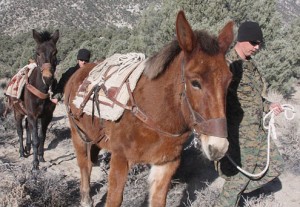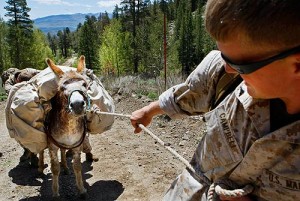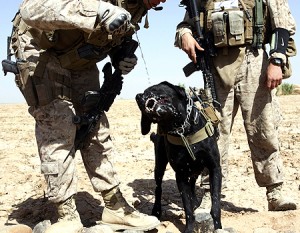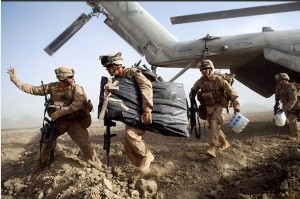Marines pushing deep into a Taliban stronghold in Afghanistan’s southern Helmand province battled insurgents in a day of firefights around a key bazaar Sunday, as an operation designed as a U.S. show of force confronted resistance from Taliban fighters as well as constraints on supplies and manpower.
Insurgents at times showed unexpected boldness as they used machine guns, mortars and rocket-propelled grenades to fight the advancing Marine forces. Although the Marines overpowered the Taliban with more sophisticated weapons, including attack helicopters, the clashes also indicated that the drive by about 4,500 Marines to dislodge the Taliban from its heartland in Helmand is running up against logistical hurdles.
The firefights erupted a day after the Marines raided Lakari Bazaar in Garmsir district, a market that the Taliban has long used to store and make weapons and drugs, as well as to levy taxes on civilians. The Taliban until now had free rein in the area because there had been virtually no Western or Afghan government presence.
“This has been their turf for a long time, and now we are in here, invading their space,” said Capt. John Sun, Fox Company commander, at his makeshift headquarters in a fabric stall inside the bazaar. “The bazaar was a huge financial and logistics base for the Taliban, and they want to get that back.”
The Marine advance began Friday when Fox Company, a unit of roughly 200 Marines, traveled in open-back trucks on a grueling, overnight journey east and south through the desert to avoid routes implanted with bombs. The Taliban has littered the main routes in Garmsir with roadside bombs, called improvised explosive devices or IEDs, forcing U.S. commanders to bar most travel by military vehicles on those roads. The number of IED attacks in southern Afghanistan has surged 78 percent over the past year, with much of the increase in Helmand.
Arriving at Lakari Bazaar at daybreak Saturday for the raid, the Marines went door to door, using explosives, rifles and axes to break into each store.
“Breaching!” yelled Lance Cpl. Travis Koehler, 21, of Fountain Valley, Calif., as he shot off a lock with his MK-12 marksman’s rifle and kicked open the door for a team of Marines to enter. “All clear!
Afghan soldiers advised by British troops searched the market and together with the Marines uncovered mortars, grenades, ammunition, and thousands of 100-pound bags of opium poppy and bomb-making materials, as well as facilities where the bombs and drugs were produced. They found tax receipts and recruiting leaflets calling on young men to join the Taliban and kill British and U.S. troops.
“The bazaar has been used by the Taliban as a staging area, weapons cache and profit base,” by taxing local vendors, Sun said.
The Taliban had left the market before the raid, however, and only a handful of shopkeepers were around, leaving it deserted but for a few cats and donkeys.
Late Saturday, Sun received word that the Taliban was regrouping in a nearby village across a canal to the west. At 3 a.m. Sunday, he launched 2nd Platoon, which includes dozens of Marines, on a foot patrol to investigate. At about 8, the patrol moved into an open field, where it was ambushed by Taliban fighters positioned in two tree lines to the south and east.
When Taliban fighters fired the first shot with an AK-47 assault rifle, Sgt. Benjamin Pratt thought one of his Marines had discharged a round accidentally, he recounted. “Hey, who shot?” he called back to his squad. But within seconds, the men realized they were under fire.
“Where is the . . . fire coming from?!” shouted Lance Cpl. James Faddis, 21, of Annapolis, Md. Faddis, in his first firefight, was the M-240 machine gunner for a weapons team that had advanced farther across the field than any other Marines and initially took the most direct fire from Taliban rifles and machine guns. Bullets were cracking around their heads and kicking up dust nearby.
“Get your gun up!” yelled Cpl. Jonathan Kowalski, 25, of Erie, Pa., ordering the Marines to fire toward the tree line to the south, where he saw muzzle flashes and Taliban fighters in dark dishdashas running between positions.
The insurgents began firing mortar rounds, honing their aim until one landed just 150 yards from the Marines. The Marines called in mortars of their own, which were fired from the bazaar onto the tree line, causing a few minutes’ lull in the fighting.
Faddis and his team scrambled and crawled to a better position, but on the way Kowalski dropped his radio. So he and the other machine gunners had to shout to the infantrymen to indicate they could move forward.
Sgt. Deacon Holton bounded into the soggy field along with Cpl. Clayton Bowman and other Marines, running and slipping through knee-deep mud saturated from recent irrigation.
As the Marines maneuvered, a Huey and a Cobra attack helicopter flew in low overhead, circling above to spot the fighters. Capt. Brian Hill, the forward air controller, put on a bright orange panel and wore it like a cape to identify the Marine position.
Often Taliban fighters flee when helicopters arrive, Sun said, but this time they stayed, and attempted to fire a rocket-propelled grenade at one of the aircraft. The Huey made two strafing runs with its Gatling guns over the tree lines, while the Cobra fired missiles, finally ending the firefight. The helicopter crew spotted at least two dead Taliban fighters.
Although the Marines asked to pursue the Taliban fighters south, more senior commanders denied the request. Sun said he thinks the problem was a lack of helicopters to provide air power and to evacuate any possible casualties, as well as roads that had not been cleared of bombs.
“Due to the limited numbers of helicopters available, it would not have been in our best interest to get decisively engaged,” Sun said. In addition, moving south would leave the bazaar open to attack, he said.
But some Marines voiced disappointment at not being able to track the Taliban, saying that decision may have allowed the insurgents to stage fresh attacks on the bazaar later in the afternoon. Faddis, Kowalski and their machine-gunning team were on guard duty in a mud-brick structure in the market that had a window facing fields to the south when shots broke out from a nearby compound. Faddis spotted a target and fired back. “They’re moving out of the compound!” one Marine yelled, unleashing another volley of machine-gun fire.
The gun battle was complicated by the presence of women, children and shepherds in adjacent fields. Having staked out a claim in Lakari Bazaar, Sun said, the question remains whether his company should continue to hold this relatively strung-out position or pull back, knowing such a move would allow the Taliban to return, at least temporarily. “That’s a dilemma,” Sun said.
We’ll cover two main points. First, this report is remarkable in that it could have been written exactly one year ago during the tenure of the 24th MEU in the Garmsir District in 2008. During that operation, the U.S. Marine Corps had taken over from the British who were not able to force the Taliban out of Garmsir, and after a major gun battle took over the Garmsir area from the Taliban. The primary concern of the residents during this operation was that the Marines would leave, allowing the Taliban to re-enter the district and punish those who had cooperated with the Marines.
The Marines turned operations back over to the British, who were then unable to maintain control of the Garmsir District, and now the U.S. Marines are back again in Helmand generally and Garmsir particularly. It’s not that the British are unable to fight, but rather that they aren’t supplied well enough, equipped well enough or provided with enough troops (we might add that their officer corps seems mostly to be sidetracked and confused with a version of counterinsurgency doctrine taken from their experience in Northern Ireland).









